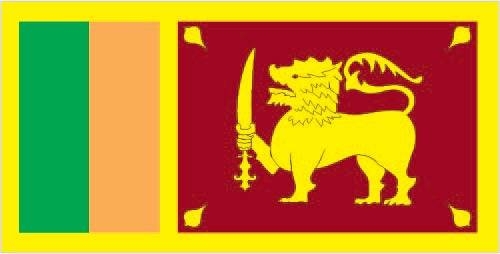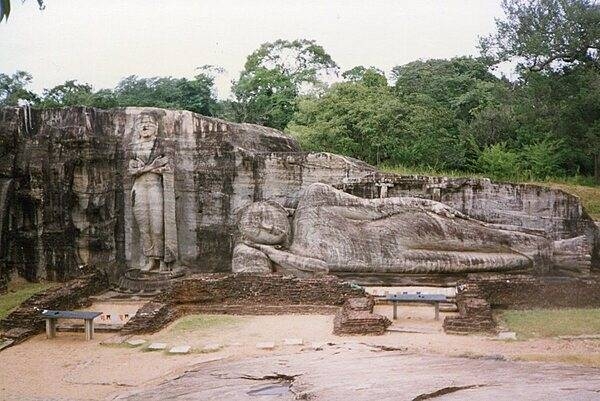165 Sri Lanka

Yellow with two panels. The smaller hoist-side panel has two equal vertical bands of green (hoist side) and orange. The other larger panel depicts a yellow lion holding a sword on a maroon rectangular field that also displays a yellow bo leaf in each corner. The yellow field appears as a border around the entire flag and extends between the two panels. The lion represents Sinhalese ethnicity, the strength of the nation, and bravery. The sword demonstrates the sovereignty of the nation. The four bo leaves – symbolizing Buddhism and its influence on the country – stand for the four virtues of kindness, friendliness, happiness, and equanimity. Orange signifies Sri Lankan Tamils, green Sri Lankan Moors, and maroon the Sinhalese majority. Yellow denotes other ethnic groups. Also referred to as the Lion Flag.
Flag courtesy of the CIA World Factbook

Map courtesy of the CIA World Factbook

The Gal Vihara (the stone temple), known originally as the Uttararama, is a rock temple of the Buddha located in the ancient city of Polonnaruwa in North Central Province, Sri Lanka. It was carved during the reign of Parakramabahu I (1153-1186). The temple consists of four rock relief statues of the Buddha, which have been carved into the face of a single granite outcropping. The reclining Buddha is just over 14 m (46 ft) in length, making it one of the largest sculptures in South Asia. The city of Polonnaruwa has been designated a World Heritage Center.
Photo courtesy of the CIA World Factbook
Government
According to Britannica, a representative, democratic system of government has existed in Sri Lanka since the termination of British rule in 1948. Elections are regularly held, and citizens over 18 years of age may vote. Fairly contested elections have resulted in several orderly changes of government since independence.
As provided for by the constitution of 1978, the government is headed by an executive president elected directly by popular vote from a national electorate. The president selects a cabinet of ministers and other non cabinet ministers from the parliament. The president is also the commander in chief of the armed forces, army, navy, and air force.
The national parliament consists of more than 200 members. The system of proportional representation that operates at the elections ensures that the number of parliamentary seats secured by each party is roughly proportional to the number of votes received by the party at the polls.
Sri Lanka’s constitution provides for certain functions of government to be devolved to provincial councils (palāth sabhā). In addition, the country has a system of local government comprising municipal councils and urban councils.
The independence of Sri Lanka’s judiciary is protected by the constitution. The Supreme Court is the highest appellate court and the final arbiter in constitutional disputes. The Court of Appeal, High Court, district courts, magistrate’s courts, and primary courts occupy, successively, the lower levels of the hierarchy. The common law of Sri Lanka is based largely on Roman-Dutch law. Principles drawn from indigenous legal traditions are applied to aspects of civil law concerning certain communities.
Civil Aviation Authority of Sri Lanka (CAA)
The Department of Civil Aviation (DCA) was established in 1946. Initially, the DCA was entrusted to undertake all regulatory, operational and commercial functions which included operating air services, airports and air navigations services. With the view to provide more administrative and financial flexibility, conducive for the efficient management of airlines and airports in a technologically challenging and commercially competitive environment, all commercial and operational activities were separated from the Department of Civil Aviation progressively and transferred to Government owned Limited Liability Companies formed under the Companies Act. Accordingly, Air Lanka Ltd., (SriLankan Airlines) was established in 1979 for the operation of regular public air transport services and Airport and Aviation Services (Sri Lanka) Ltd., for development, operation and maintenance of civil airports and provision of air navigation services in 1983. Thus the DCA was confined to the role of the regulator. It retained a typical government departmental structure, not realizing the need to adjust itself over the years to develop the capability to regulate an aviation industry growing rapidly alongside the robust technical advancement in aeronautics. This situation continued undetected until the world aviation governing body, the ICAO found serious deficiencies in the DCA during an assessment conducted in 1997. It was that the DCA was found to be deficient in maintaining safety oversight of the aviation industry, implementing International Safety Standards and Recommended Practices, certifying the aviation industry, maintaining safety surveillance over their operations and taking enforcement action to remedy deviations from safety standards, rules and practices. The ICAO report highlighted the lack of the Organization, absence of required number of technical staff and their training, outdated aviation legislation, regulations and lack of guidance material and processes for effectively regulating the industry. It was under the premises aforementioned, the Civil Aviation Authority (CAA) of Sri Lanka was established in 2002 in terms of the Civil Aviation Act No.34 of 2002 as a direct measure of remedying the organizational deficiencies that prevailed. The new Organization ought to have more autonomy and flexibility as per the recommendation of ICAO for greater efficiency and effectiveness to accomplish its obligatory duties.
Airspace
SkyVector – Google Maps – ADS-B Exchange
ICAO countries publish an Aeronautical Information Publication (AIP). This document is divided into three parts: General (GEN), En Route (ENR) and Aerodromes (AD). ENR 1.4 details the types of airspace classes they chose to adopt from classes A through G.
Drone Regulations
Advanced Air Mobility (AAM) Regulations & Policies
Advanced Air Mobility (AAM) News
2025
Video courtesy of Advanced Air Mobility Institute from the January 2025 Global AAM Forum. Complete session for Day 2 of this Forum is available on the Advanced Air Mobility Institute YouTube Channel
Short Essay Questions
Scenario-Based Question
You have been hired by a Drone Startup Company. Your boss has immediately assigned this job to you.
They need you to prepare a one-page memo detailing the legalities of using a drone to film the stone temple, pictured above.
They need you to mention any national laws and local ordinances.
They specifically want to know what airspace (insert pictures) you will be operating in and whether or not you need an airspace authorization.
Does it matter whether or not you are a citizen of the country?
Lastly, there is a bonus for you if, as you scroll through this chapter, you find any typos or broken links!
Short Essay Questions
- What are the drone categories?
- How is registration addressed?
- How is remote ID addressed?
- What are the model aircraft rules?
- What are the commercial drone rules?
- Are there waivers or exemptions to the rules? If so, for what?
- Would you share a link to an interactive airspace map?
- How is BVLOS addressed?
- How can you fly drones at night?
- How can you fly drones over people?
- Where do you find drone NOTAMs?
- What are the rules for drone maintenance?
- What are the rules for an SMS program?
- What are some unique rules not mentioned above?
- What are the C-UAS rules?
- What are the AAM rules?

